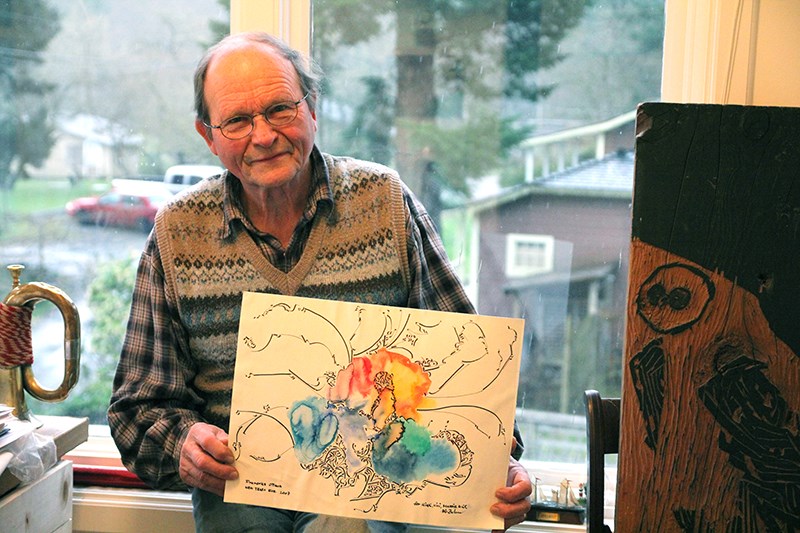Less than one year ago, just weeks before the end of term at Capilano University, students in the fine arts program learned that their department was closing. The younger students enrolled in the Studio Arts program would be able to complete their two-year diplomas, but for mature students in the Art Institute program, the closure meant their education at Capilano was coming to an end. Bowen Islander Hans Christian Behm was one of them. On Monday, he asked Bowen’s municipal council to pass a resolution asking the governors of Capilano College to declare a moratorium on the program’s closure.Behm says that Bowen Island and other North Shore municipalities will suffer because of the closure of Capilano’s fine arts program, because its graduates receive a unique education which prepared them for a lifetime of contribution in artistic fields but also one which prepared them with the skills and tools required to live well and engage with others.
Behm, who is 74 years old, started his career as an artist in 2008 with his entry into the Capilano Art Institute.
“My daughter in-law’s grandmother recommended me, and when I told them that I used to be an architectural designer they were really happy to let me in because they valued my experience,” says Behm.
Behm says the relationship between the Art Institute, which could be compared to a residency for mature artists, and the Studio Arts program was one of mentorship.
“Wayne Eastcott, who is one of Canada’s premiere printmakers, this was his idea,” says Behm. “The philosophy is that the more experienced people can demonstrate skills and help to engage the younger students, and in return they offer us the sense of excitement, and the newness of life. The young people I worked with over the years in this way have become like family to me in a way, and when I liked their work, I would trade them for it, and so I am invested in their careers.”
Behm says he was always astounded by the discipline, concentration, and dedication of the young students he worked with.
“I never saw a fight among them,” he says.
Behm says that the school’s resources, both in materials and in the knowledge of their teachers, are invaluable.
“I will be devastated to see the materials sold for scrap,” he says. “In the printmaking studio we had a printer worth $27 thousand, and what will happen to that? When you look at the bronze foundry, you have all of this casting equipment, cauldrons, moulds. These are things that on their own are not valuable; it is in this context they become extremely valuable.”
Behm says that the school’s bronze foundry was run by George Ramel, “Bill Reid’s main man, and one of Canada’s greatest sculptors.”
“As Bill Reid’s Parkinsons progressed, it was Ramel who would execute his ideas,” says Behm. “I saw George Ramel on his knees at 6am trying to help a student finish up his graduation project. His dedication to them is incredible.”
Bowen-based artist Josh Van Dyke, who was set to enter the Art Institute Program just prior to its closure, but had the already attended Capilano as a student in the Studio Arts program in 2002.
“It was a really amazing experience,” says Van Dyke. “At Capilano you actually learned how to make things, how to paint or how to build, which is a refreshing alternative to other schools.”
He says that after a stint learning metalwork in Scotland, he was inspired to go back to Capilano in part because of the access it would provide him to their foundry.
“As an artist, I expect these kinds of hiccups,” he says. “I can’t build a metal foundry at my house, but there are various options for accessing foundries. What I can’t replace that I would have gotten at Capilano was the opportunity to work with people like George Ramel. I know that he is someone I could learn a lot from, but also someone who knows how to just let his students be artists.”
Another Bowen-based artist, Gregg Simpson, is supporting Behm in his bid to keep Capilano’s Studio Arts programs alive.
“Art schools these days are not like when I went to the Vancouver School of the Arts, when everything smelled like oil paint,” says Simpson. “They are about theory, and cultural theory. This kills the poetic spirit, and people don’t want to go see art that comes from a place like that.”
Simpson says he has received a letter from North Vancouver Mayor Richard Walton saying he would write a letter asking for a moratorium on the closure of the Capilaon fine arts program.
“We’re not going down without a fight,” says Simpson.
Mayor Jack Adelaar told Behm that he has already written one letter against the closure of the art program at Capilano.
“I believe I have a good relationship with other mayors, and I’d be willing to stick my oar in the water for you on this issue,” he said.
Council decided to wait until April 14 to make a decision about Behm’s proposed resolution.
Behm says that time is of the essence, and he will move forward on bringing his request before the other municipal councils as soon as possible.



